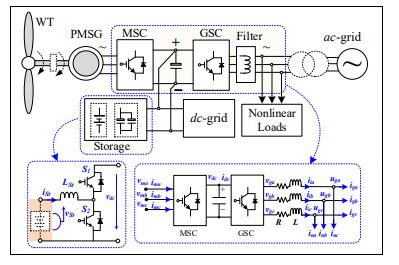Multifunctional Control of Wind-Turbine Based Nano-Grid Connected to Distorted Utility-Grid
Objective
The main objective of this project is to improve the quality of generated power into the grid.
Abstract
In this project, a multifunctional control strategy and associated control algorithms for distributed wind-turbine (WT) based nano-grids connected to a distorted utility-grid. The contribution is on a new strategy with innovative control algorithms to coordinate multiple converters for a multitasking operation of the nano-grids. The novelty is on a unique control design with feasibilities: maximizing the generated power from WT, maintaining power quality in both ac- and dc-sides under critical conditions of the power grid, and improving power quality against distortion from local nonlinear loads under a reduced switching frequency. A robust fast-dynamic predictive control method is developed for current controllers to fulfil the multifunction. Unconstrained deadbeat control inputs are derived in twofold targets: ensuring fast dynamic response and significantly reducing both the computation and switching frequency for finite predictive control.
The control system is applied on a permanent-magnet synchronous generator (PMSG) WT-based nano-grid connected to a distorted utility-grid. An OPALRT-based real-time platform is used for comparative studies among the proportional integration (PI) control, finite predictive control (FS-MPC), and proposed control method.
The performance verification exhibits the power quality improvement in both the nano- and utility-grids under critical conditions via high-performed regulation of currents, voltages, reactive power, and rotor-speed of the PMSG-WT.
Keywords: Deadbeat control, distortion, finite predictive control, harmonic, permanent magnet synchronous generator (PMSG), wind energy conversion system, unbalanced and distorted grid.
NOTE: Without the concern of our team, please don't submit to the college. This Abstract varies based on student requirements.
Block Diagram

Specifications
Software Configuration:
Operating System : Windows 7/8/10
Application Software : Matlab/Simulink
Hardware Configuration:
RAM : 8 GB
Processor : I3 / I5(Mostly prefer)
Learning Outcomes
- Introduction to Matlab/Simulink
- What is EISPACK & LINPACK
- How to start with MATLAB
- About Matlab language
- About tools & libraries
- Application of Matlab/Simulink
- About Matlab desktop
- Features of Matlab/Simulink
- Basics on Matlab/Simulink
- Introduction to controllers.
- Study of PWM techniques.
- Project Development Skills:
- Problem analyzing skills
- Problem solving skills
- Creativity and imaginary skills
- Programming skills
- Deployment
- Testing skills
- Debugging skills
- Project presentation skills
- Thesis writing skills


 Paper Publishing
Paper Publishing
